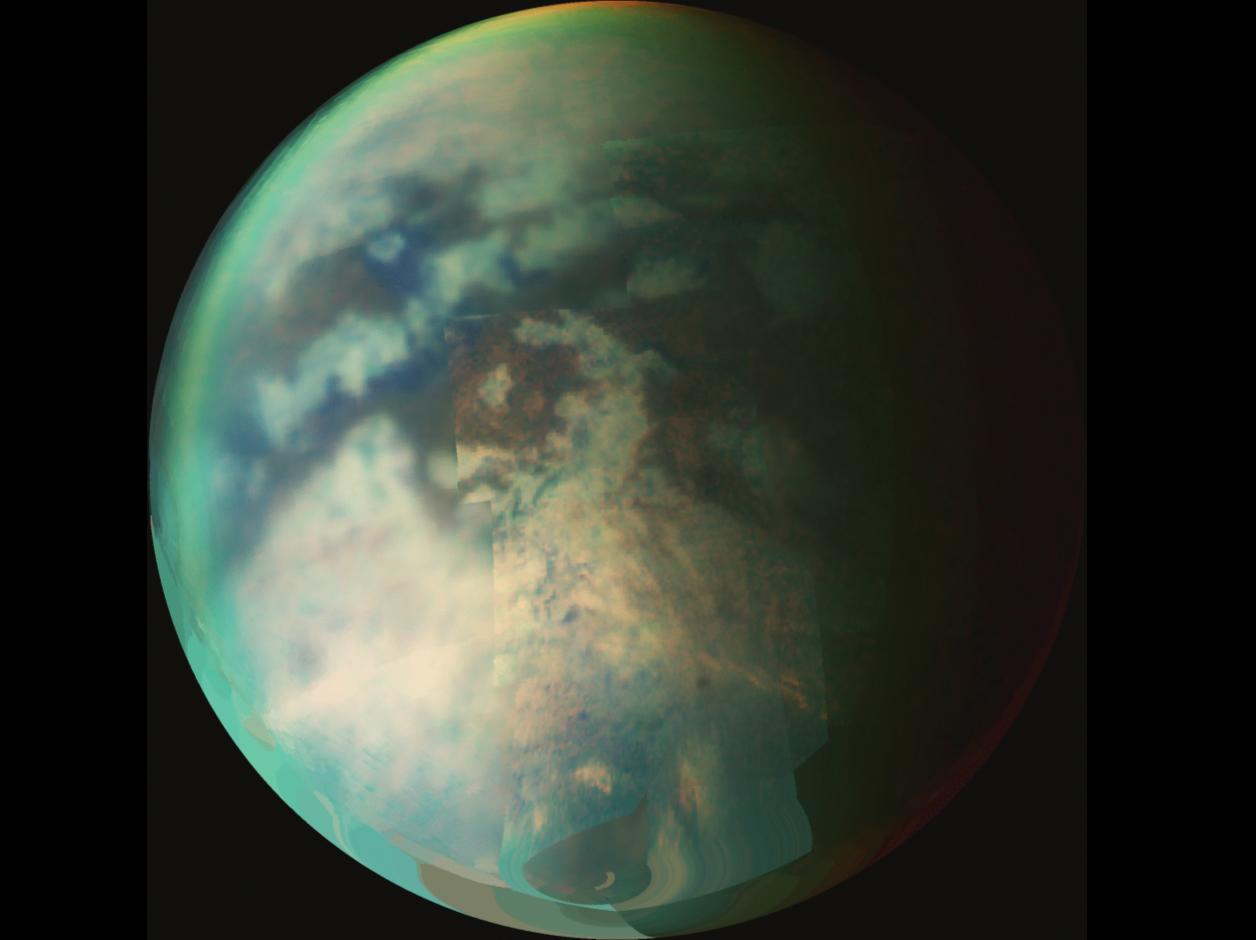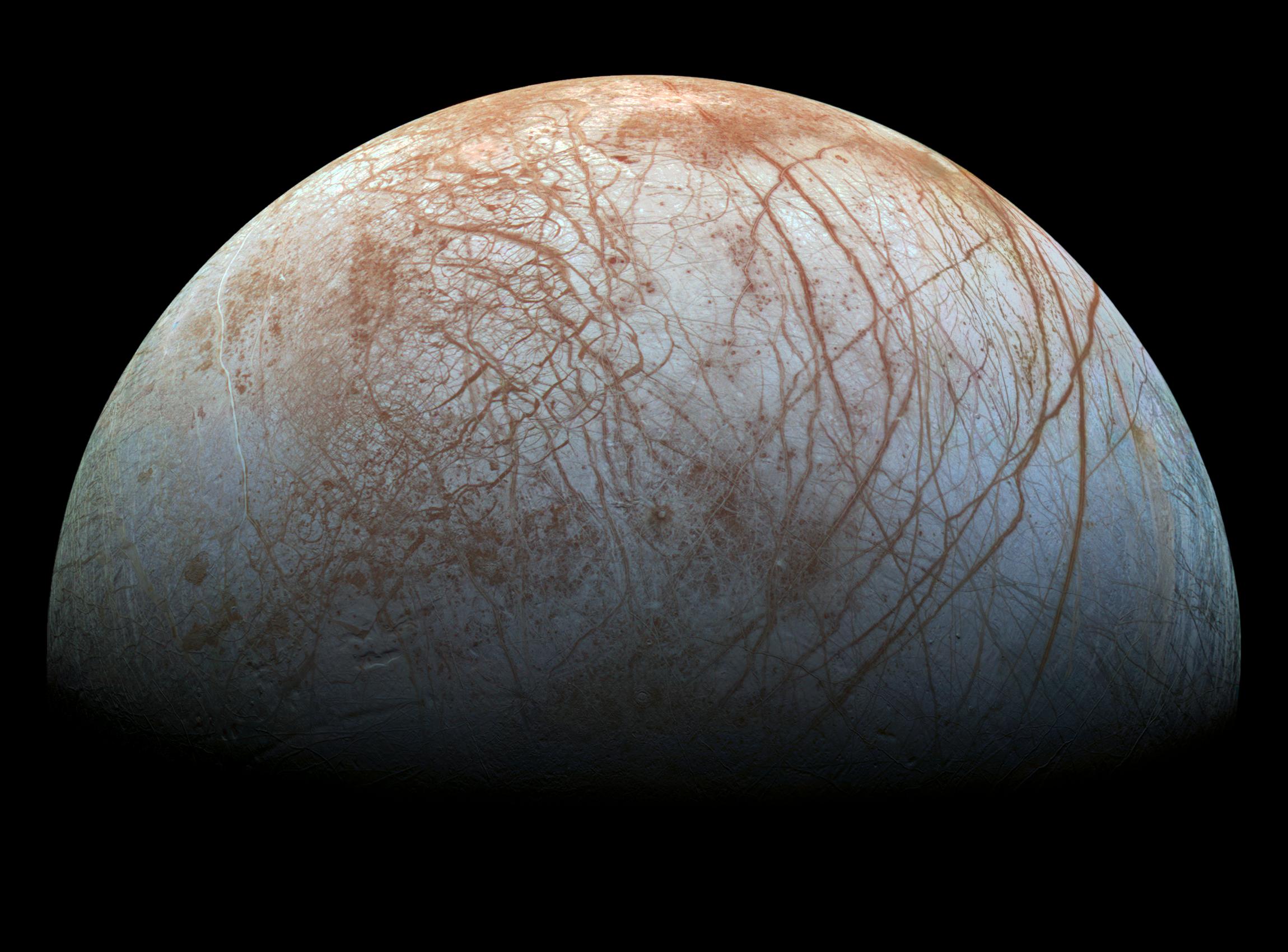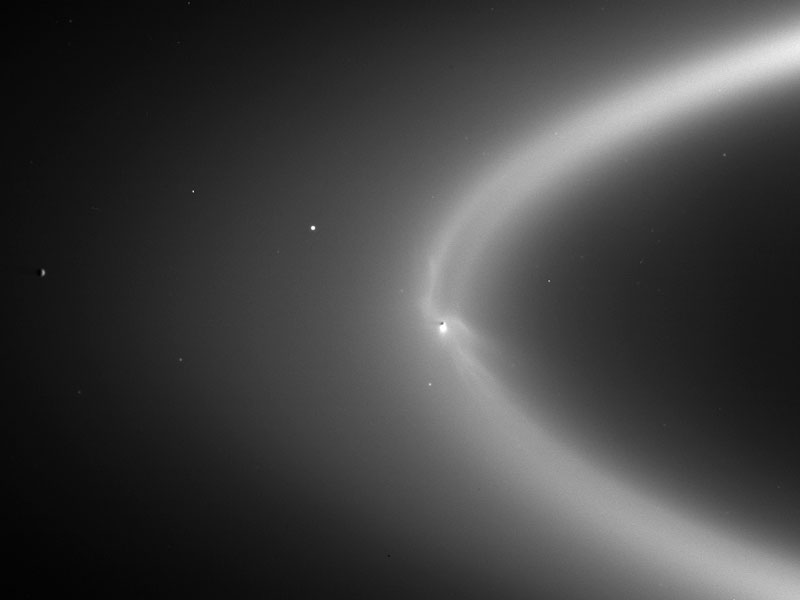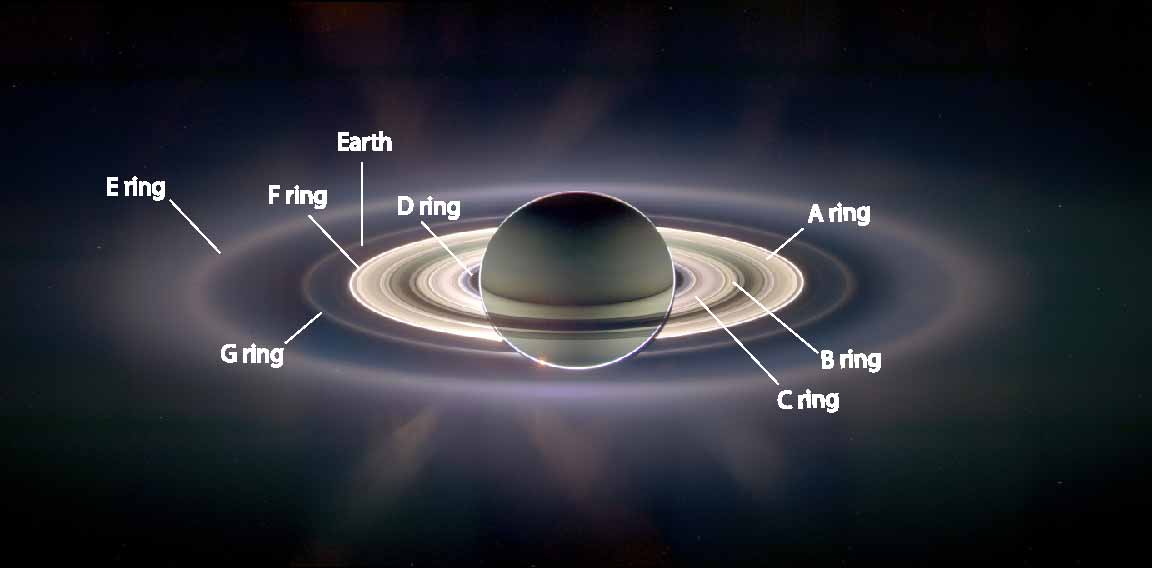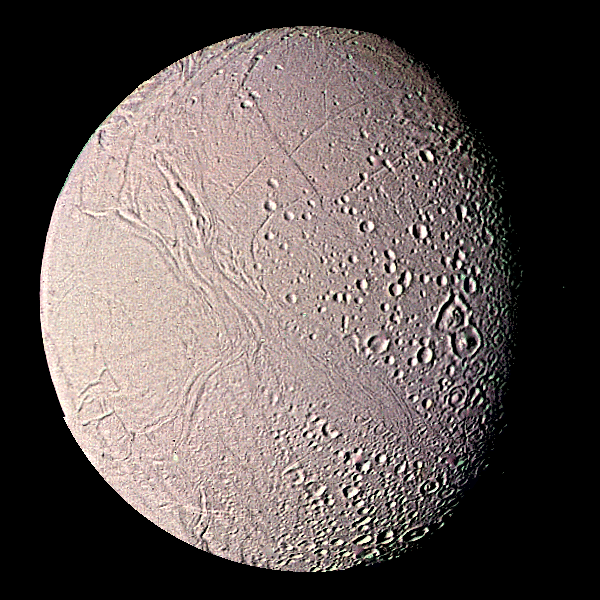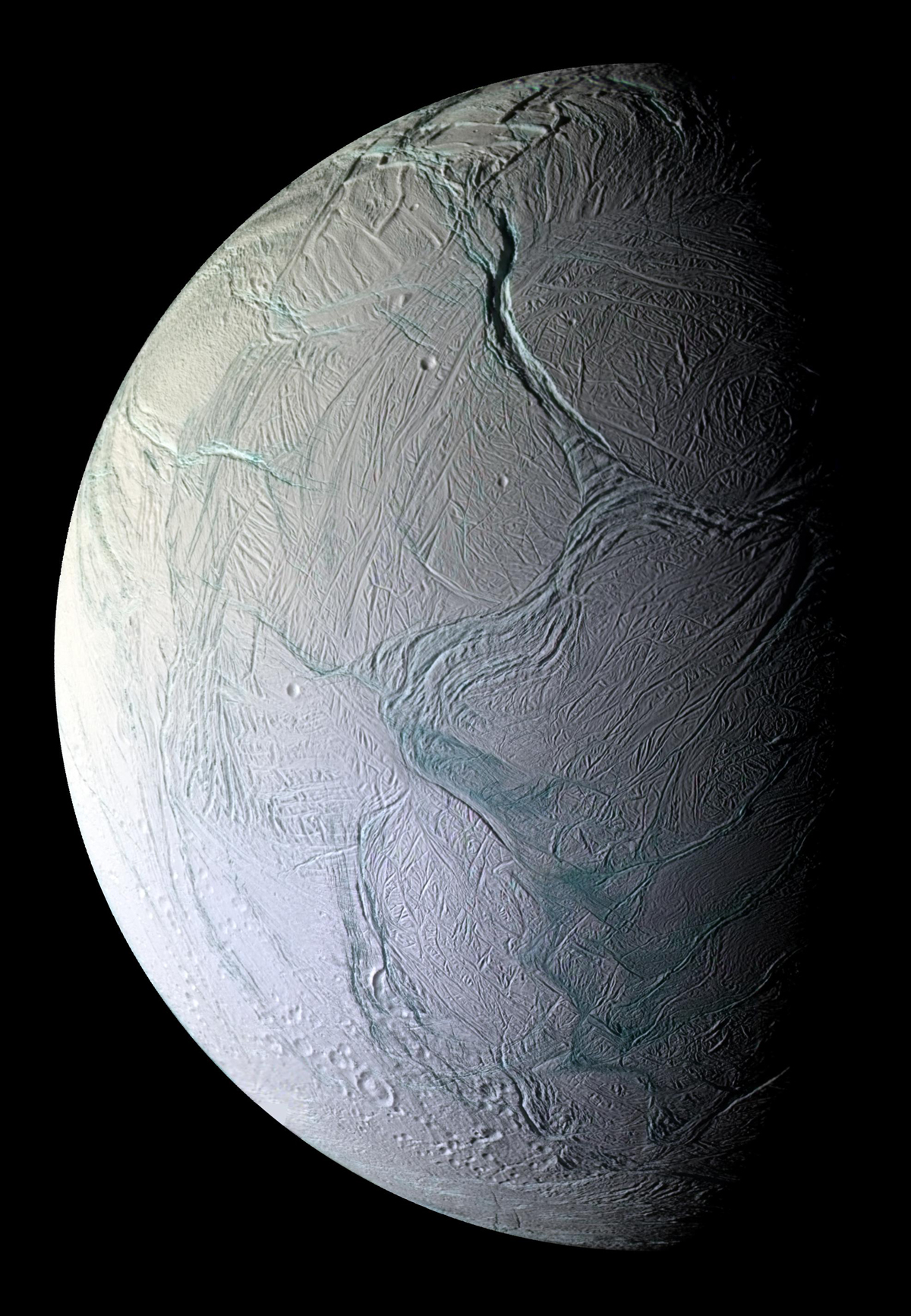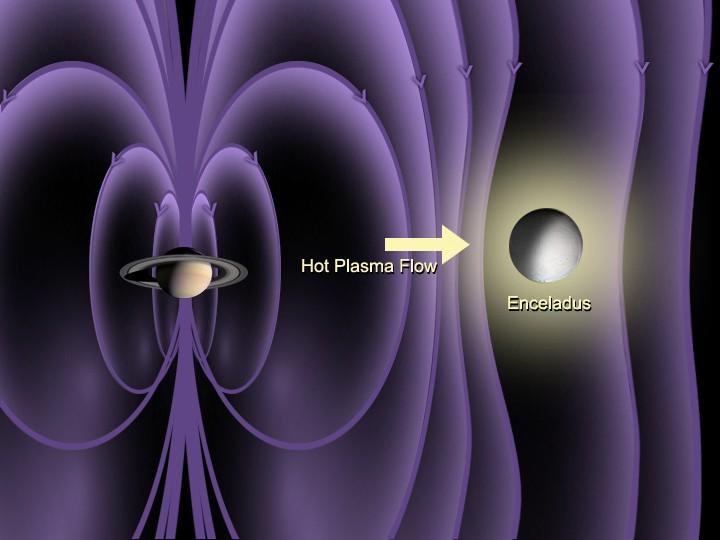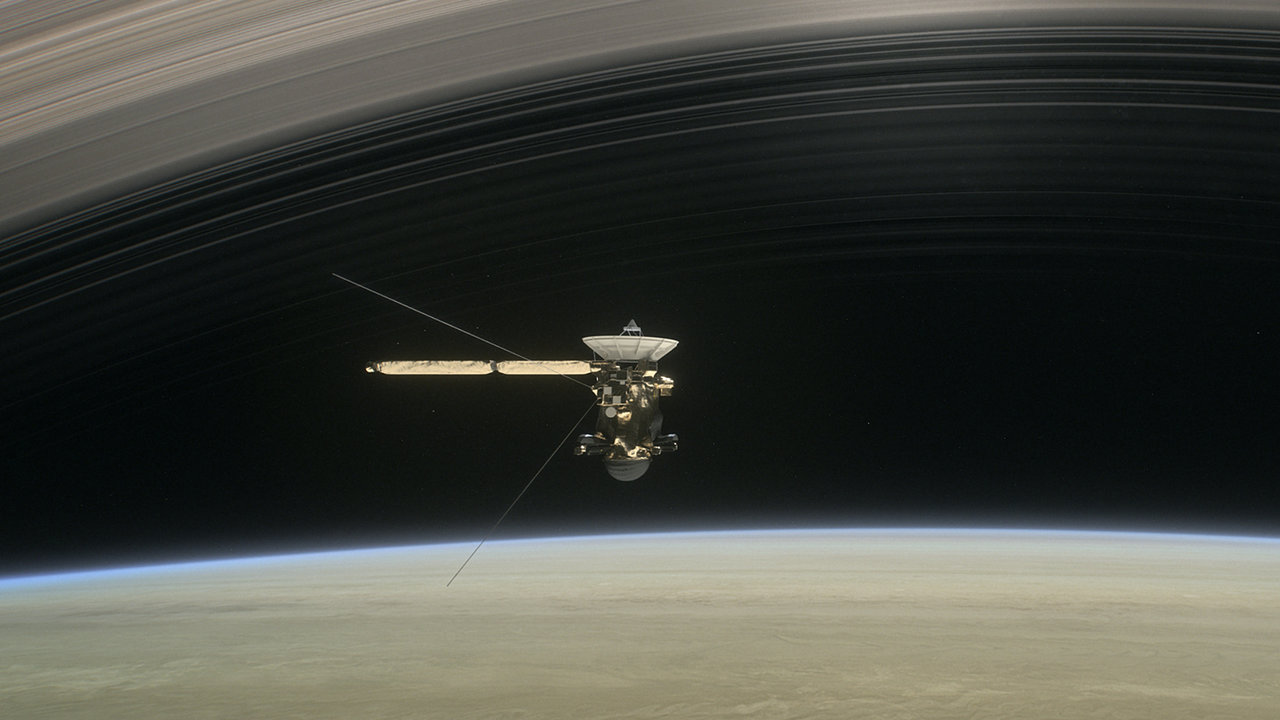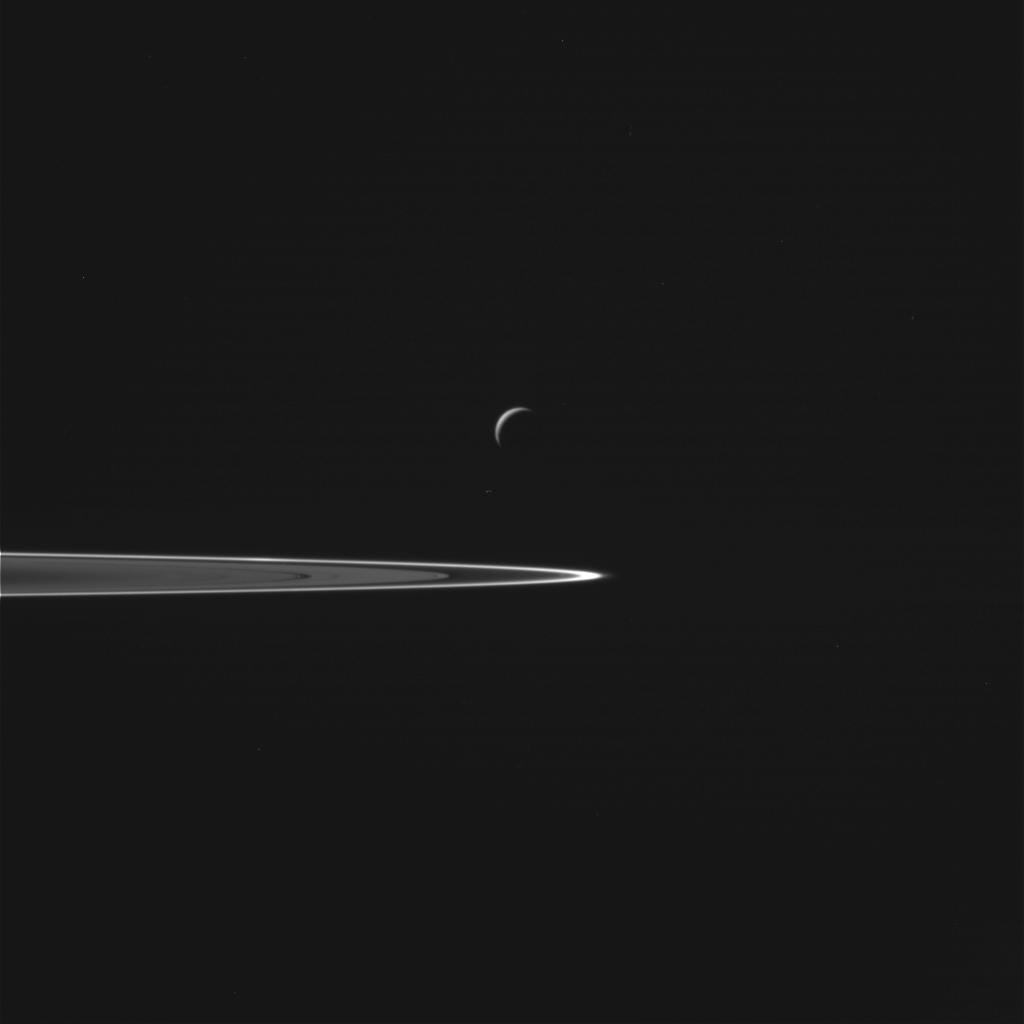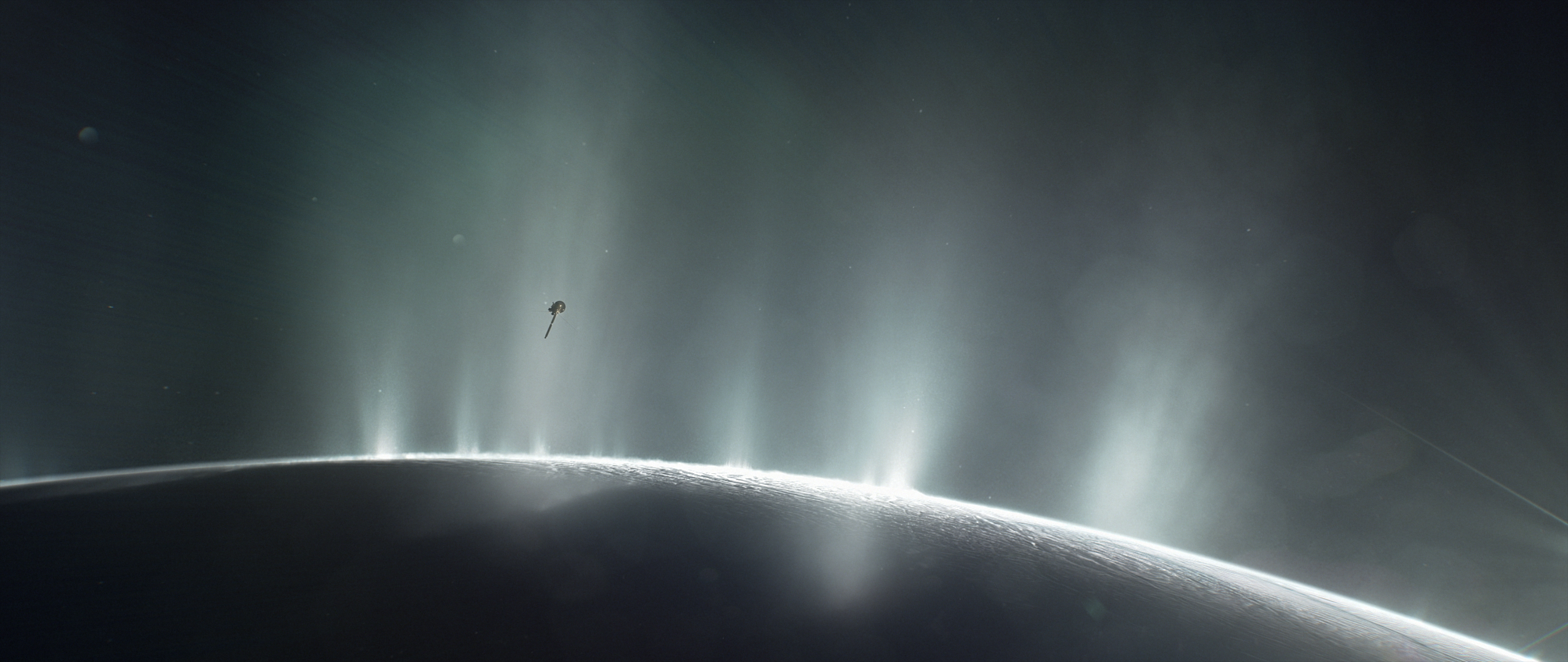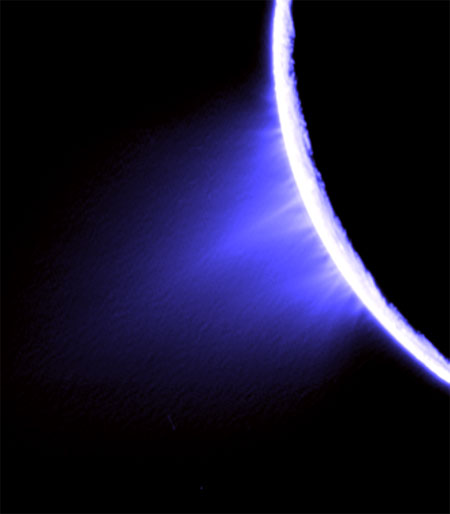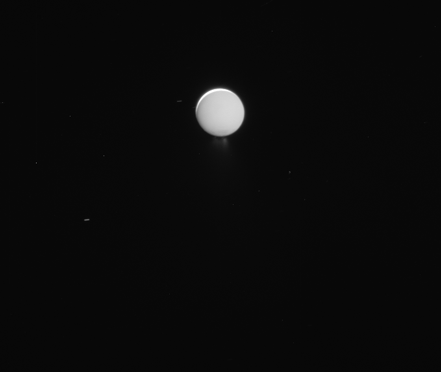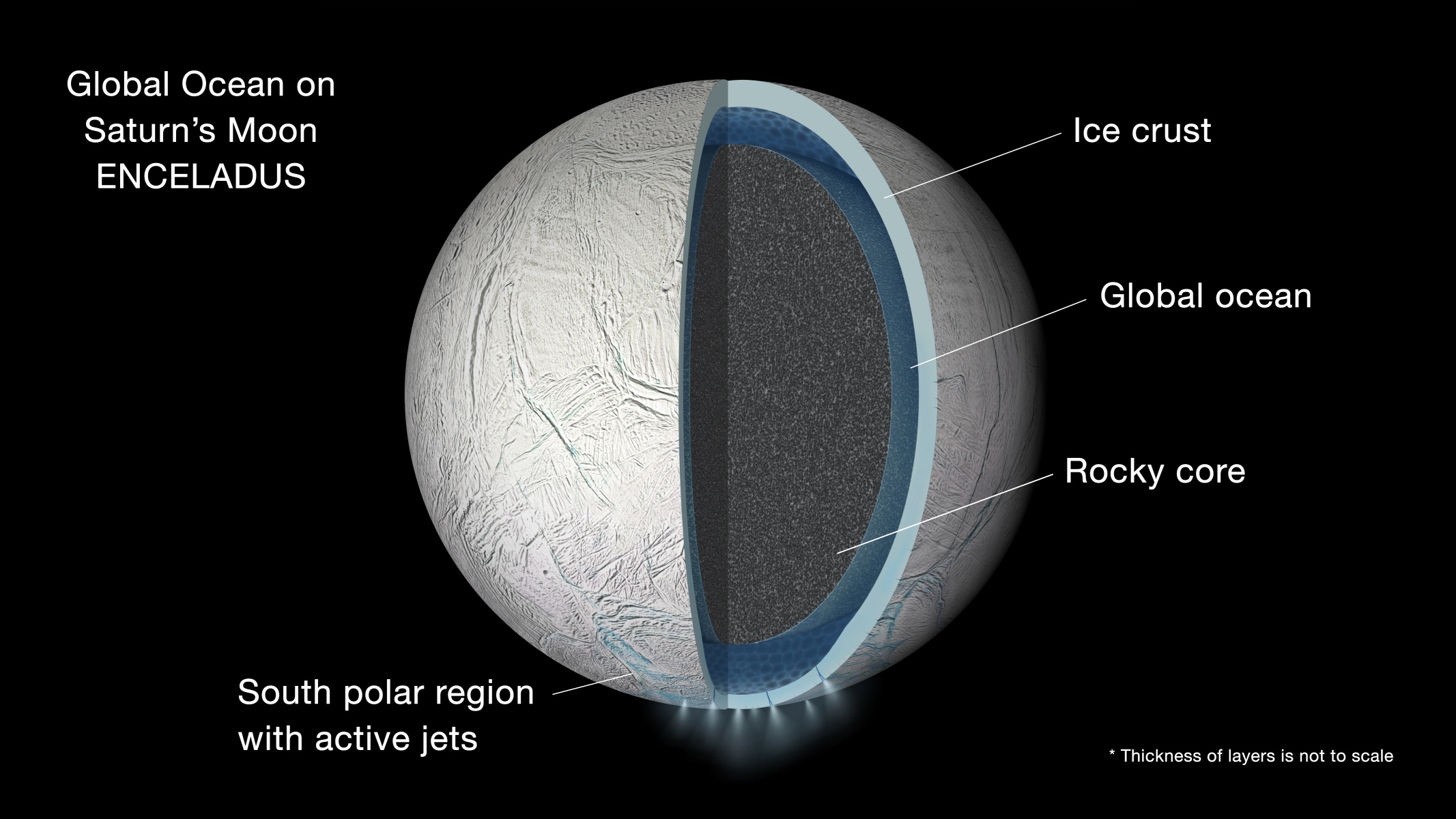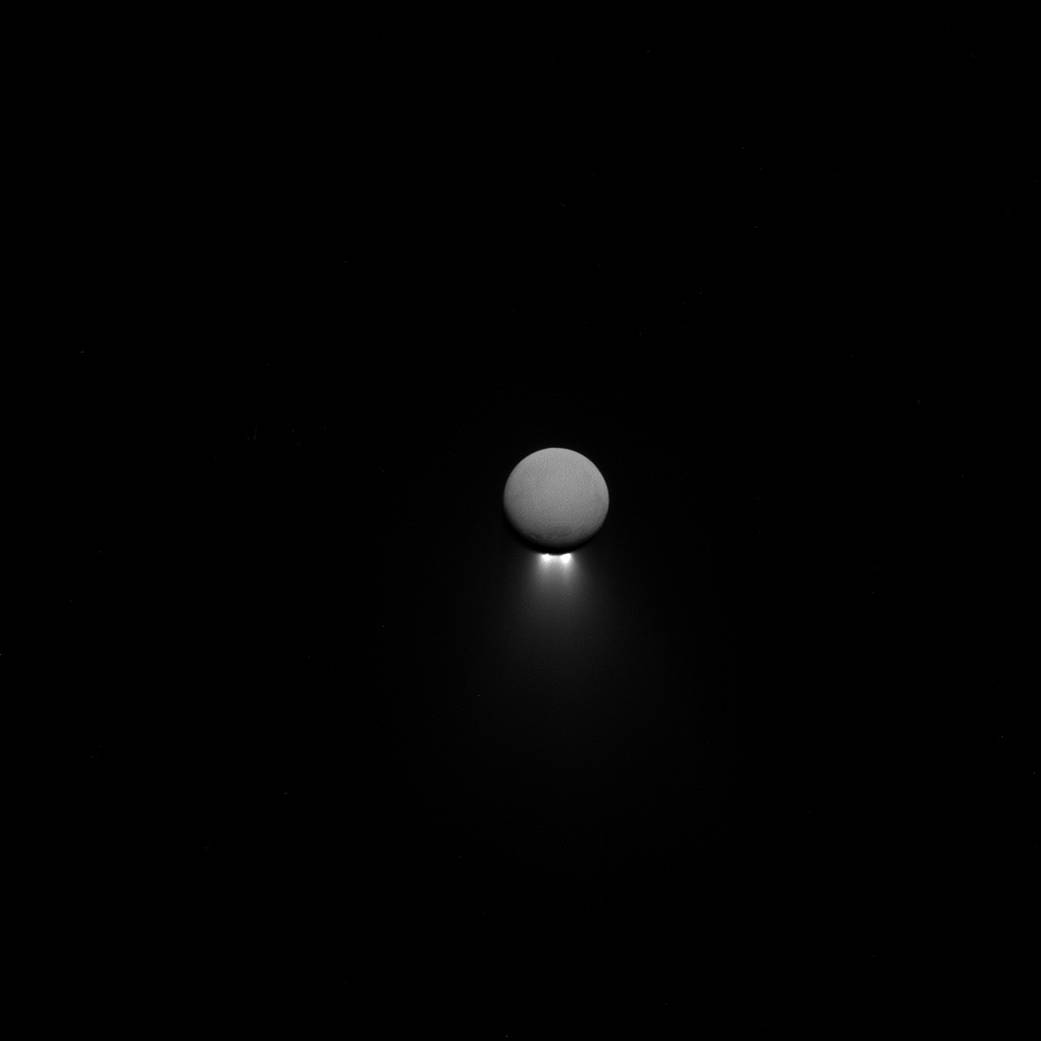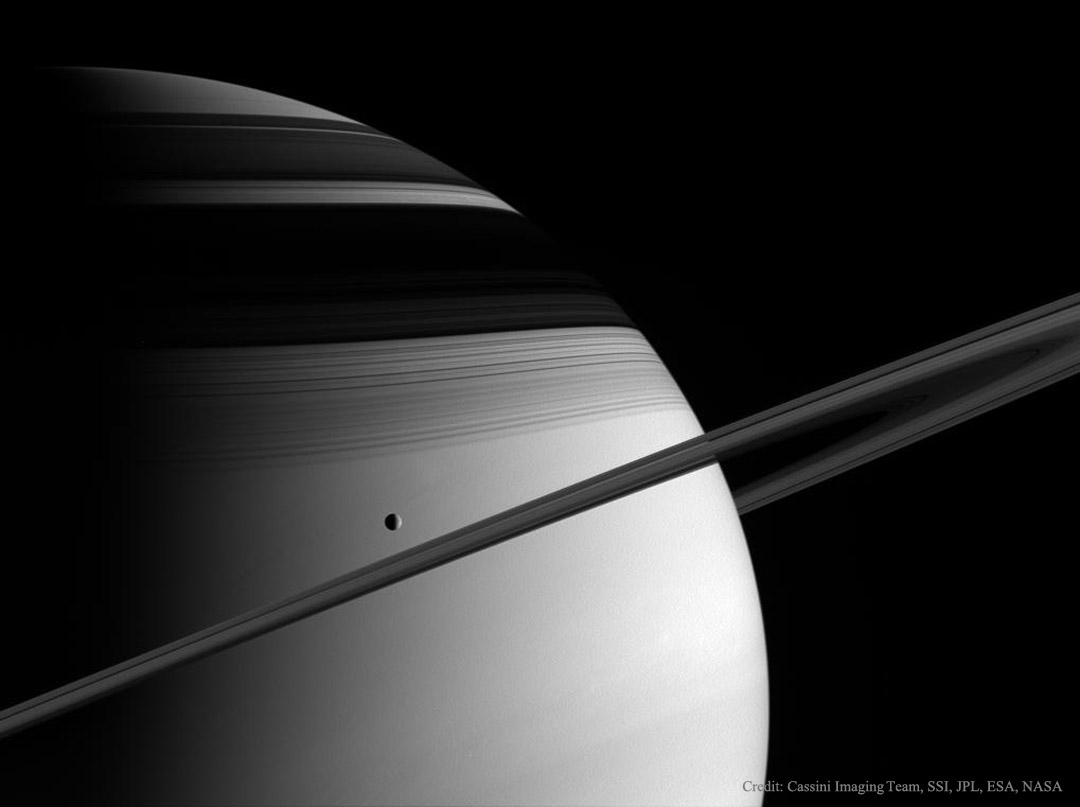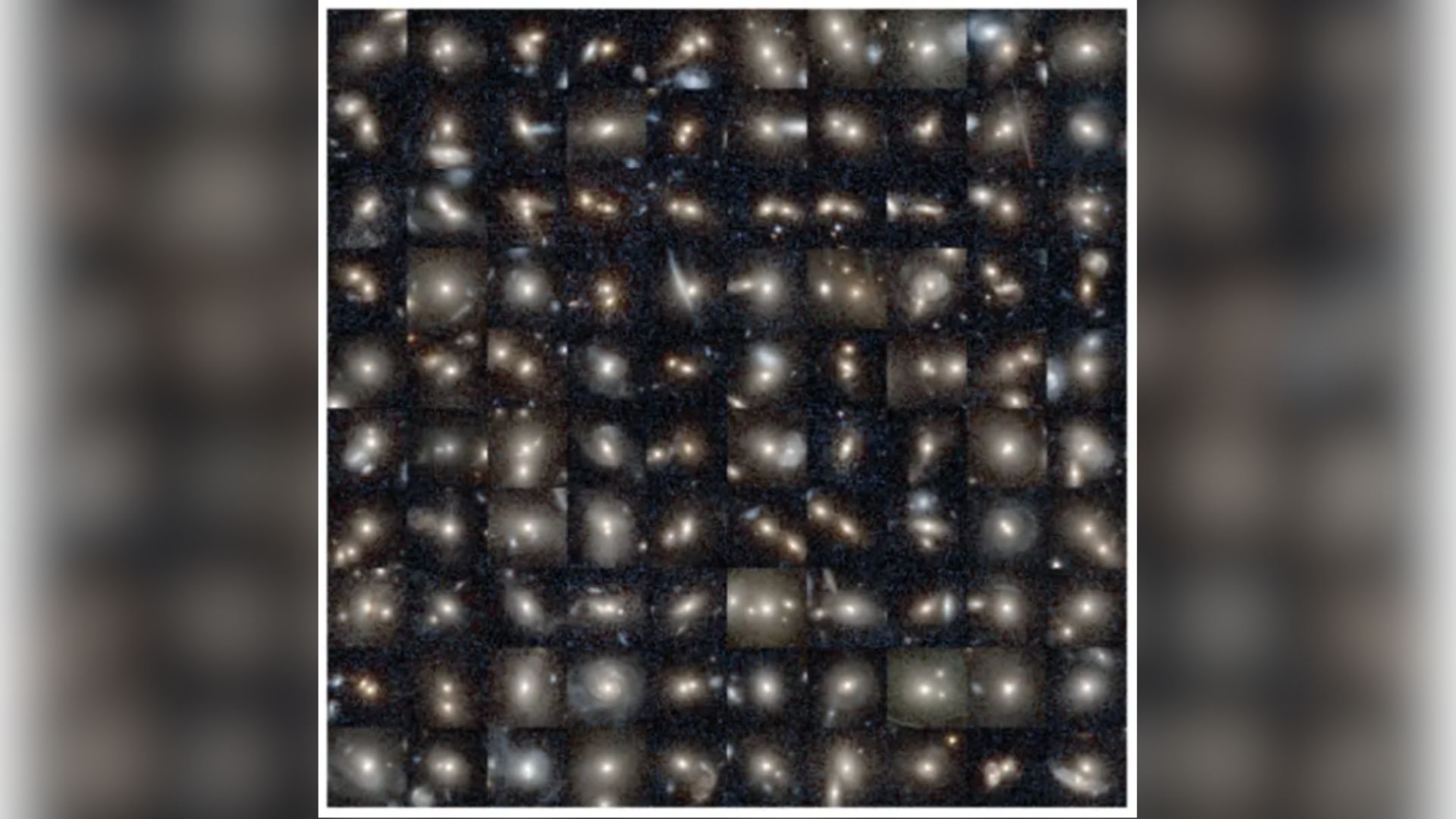How Cassini Mission's Twists and Turns Led to Discovery of Enceladus' Plumes
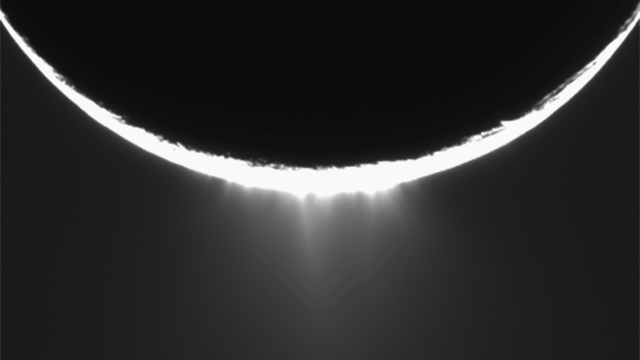
If life exists somewhere in the solar system beyond Earth, there's a good chance it will live underground. Or in the case of Saturn's moon Enceladus, under a thick layer of ice, in a salty ocean. The discovery that Enceladus hosts such an environment is one of the major legacies of the Cassini mission at Saturn, but scientists almost missed the evidence for this revelation all together.
The trail of crumbs that led scientists down this path to this discovery — to the revelation that Enceladus is much more than just a solid ball of ice — goes back decades, but a turning point came when NASA's Cassini spacecraft found water plumes erupting from Enceladus' surface in 2005. Years of follow-up studies of the plumes by Cassini gradually built a more complete picture of this tiny but dynamic moon.
The Voyager 2 probe, which flew by Saturn in 1981, missed a possible sighting of the plumes due to a malfunction with the spacecraft's hardware. The Cassini probe flew past Enceladus twice in 2005, and only one of its instruments saw any sign of eruptions on the satellite's surface. [Photos of Saturn's Moon Enceladus]
It started with Voyager
Before humans started sending probes to Saturn and Jupiter, there was an assumption among scientists that the moons around those planets were "dead ice balls" or solid chunks of rock, according to Bonnie Buratti, a senior research scientist at NASA's Jet Propulsion Laboratory.
In reality, the moons are about as dynamic and varied as the solar system's planets.
A few examples: The surface of Saturn's moon Titan is a sort of bizarro version of Earth, with lakes and oceans dotting its surface that are filled with liquid methane rather than water. It is the only other body in the solar system besides Earth with liquid on its surface. It also rains methane there, and scientists have spotted mysterious "islands" in the methane seas that appear and disappear periodically. Jupiter's moon Io, which is only slightly larger than Earth's moon, is the most volcanically active body in the entire solar system. It hosts hundreds of active volcanoes on its surface that can spew plumes of material 190 miles (330 kilometers) into the sky. Europa, another Jovian moon, may have a subsurface ocean and water plumes erupting from its surface like Enceladus, but its icy crust is distinct, thanks to dozens of dark red and brown streaks that make it look like a fractured egg, or a massive Gothic yarn ball.
Breaking space news, the latest updates on rocket launches, skywatching events and more!
Even the moons that are basically just hunks of rock or ice — such as Dione, which is nearly the size of Mercury with a surface that hasn't shifted or changed in about 4 billion years — have proved to have subtly different histories and features.
"They're all so unique," Buratti said of the moons. "There's hardly any one that is like the other."
In 1981, when the Voyager probes sped past Saturn, scientists hadn't yet studied many of these moons up close, and this picture of the Jovian and Saturnian moons as dynamic, unique worlds had not yet been established.
So, it was immediately surprising when the Voyager 2 images of Enceladus came back, and revealed that this tiny moon seemed to be creating one of Saturn's rings.
Unlike the planet's more famous rings — those beautiful opaque swoops of color that look like a vinyl record looping around the gas giant — the E ring is extremely diffuse, like a cloud of mist. The ring is located outside those more famous rings (which are named with letters A through D), and it is the second largest planetary ring in the solar system, with a width of about 620,00 miles (1 million km).
The E ring is also puffier than its neighbors, with a maximum width of about 2,000 miles. Voyager showed that Enceladus sits in the thickest part of the E ring, suggesting that this tiny moon was somehow spewing material into space and building it up over time.
It's conceivable that a moon or planet with a thick atmosphere might leak enough material into space to create a planetary ring, but a moon as small as Enceladus doesn't have enough gravity to hold on to a thick atmosphere, according to scientists with the Cassini mission. The satellite is only about 314 miles wide (515 km) or about the size of Ireland. (Earth's moon, for comparison, is about 2,150 miles, or 3,460 km, wide.)
The E ring could also be explained by some sort of eruption coming from Enceladus; a geyser or a plume spewing material — including water ice — into space. This plume hypothesis was also supported by another enticing piece of information from Voyager 2: Enceladus' surface is brilliantly, blindingly, overwhelmingly bright.
"Its surface is as bright as freshly fallen snow," according to Buratti, who did one of the first analyses of the Voyager observations of Enceladus' surface.
White or light-colored surfaces — like water ice — reflect more sunlight than darker surfaces; and smooth surfaces reflect more light than cratered ones. Enceladus is one of the brightest objects in the solar system, but if it were an unchanging ball of ice, then it should have accumulated more dirt and meteorite impacts during its lifetime, Buratti said. Instead, it looked as though its surface had occasionally been wiped clean or blanketed over with new layers of ice.
"In my opinion … the fact that Enceladus was so bright was very good evidence of some type of active geology," she said. "We thought there was some kind of active process going on to keep coating it in this fresh ice."
Buratti said she recalls that the plume hypothesis was viewed as a very plausible explanation, based on the available evidence. But other Cassini scientists, including Linda Spilker, the project scientist for the mission, said they remember most scientists being skeptical of that idea.
"This got a lot of attention in the Voyager days, and I would say most people doubted that there was any sort of eruption from Enceladus," Larry Esposito, principal investigator for the Ultraviolet Imaging Spectrograph (UVIS) on Cassini, told Space.com.
"The plume really was an exotic explanation; we'd never seen anything like this on another object in the solar system," Buratti said. "Scientists try to explain things by the most common and ordinary explanation, and I think really the only thing against [the plume hypothesis], was Occam's razor."
These types of debates are a central part of science, Buratti said, and ultimately the researchers simply needed more up-close observations of Enceladus to solve this mystery. Unfortunately, scientists would have to wait more than two decades for that to happen.
Cassini arrives
The Cassini-Huygens mission — a joint effort by NASA and the European Space Agency — left Earth in 1997 and arrived at the Saturn system in 2004. (The Huygens probe separated from Cassini and plopped down on the surface of Saturn's moon Titan in 2005.)
Esposito has been the principal investigator for UVIS since the mission's start, and he said one of his team's primary goals at Enceladus was to follow up on Voyager's observations, and either prove or disprove the hypothesis that the moon had an atmosphere or was erupting.
In February 2005, the spacecraft moved in such a way that the UVIS instrument could conduct a stellar occultation of Enceladus. During a stellar occultation, a star passes behind the moon or planet, and the light from that star illuminates the area close to the object's surface, potentially revealing the presence of an atmosphere or geysers spewing up from the ground. That occultation would illuminate part of Enceladus' equator.
"We got the data back from the February 2005 occultation and there was just absolutely nothing to see," Candy Hansen, a project scientist on UVIS, told Space.com. "On the one hand, not surprising; but also a bit disappointing."
The negative results continued to roll in. In March and April, Cassini did its two close flybys of Enceladus, coming to within about 620 miles (1,000 km) of the surface.
Ten of the 11 instruments on board found no obvious signs of plumes or an atmosphere.
But one of the instruments did see something. The magnetometer instrument (just called the Mag for short) saw a very peculiar feature around Enceladus.
"It was like the magnetic field lines of Saturn, which were moving towards Enceladus, were being draped upstream of Enceladus, almost like there was an obstacle [above the moon] … but a larger obstacle than the body itself," Michelle Dougherty, principal investigator for Cassini's magnetometer instrument, told Space.com.
However unlikely it seemed, the researchers were seeing what looked like an extended atmosphere above Enceladus, Dougherty said. (In fact, NASA's Jet Propulsion Laboratory put out a news release stating that the flybys "have revealed that the moon has a significant atmosphere," although the statement went on to describe the finding in slightly less definitive terms.)
In retrospect, scientists with the Cassini mission say this was the first solid detection of Enceladus' plumes. But at the time, the questions that had plagued the Voyager observations still remained — how could such a small moon hold on to an atmosphere that extended so far above the surface, and why hadn't the other instruments seen anything? If the material was from plumes, where was Enceladus hiding the supply of water that would fuel those ejections?
The magnetometer data alone wasn't enough to confirm the existence of an atmosphere or eruptions on Enceladus, especially considering that none of the other instruments had detected anything, and the UVIS flyby had found no atmosphere at the planet's equator. The next logical step was to get in closer to Enceladus and see what the other instruments could find.
So, Dougherty went from London, where she worked at Imperial College London, to NASA's Jet Propulsion Laboratory in Pasadena, California, to propose that during Cassini's next flyby of Enceladus, instead of coming to within 1,000 km of Enceladus, the probe drop to within 107 miles (173 km) of the moon's surface.
Getting closer
There are no gas stations around Saturn. Every bit of fuel that Cassini had on board, it had carried all the way from Earth. If the probe ran out of fuel, the mission would be over — and, in fact, the Cassini mission planners had no choice but to end the mission in September 2017 because it had used up all but about 1 percent of its fuel.
So, when Dougherty and the magnetometer team asked the mission planners to send the probe closer to Enceladus, they were also asking to use extra fuel, which essentially meant shaving time off the mission.
"This was a big deal," Esposito said of the magnetometer team's proposal. "Everybody was very cautious about using fuel for only the most justified sorts of changes in the mission."
More than a decade later, Dougherty said she feared that if she persuaded the other mission team members to change course, and the flyby turned up nothing, "no one would ever believe anything I said ever again."
Despite her anxieties, the scientists on the mission were enthusiastic about the change, Spilker said. The magnetometer data had, just like Voyager's observations, provided clues that hinted at something fascinating taking place on Enceladus. But unlike with Voyager, which flew past Saturn, never to return, Cassini had the opportunity to investigate further.
Cassini's primary mission was to explore the Saturn system for four years. Its path had been planned years ahead of its arrival at Saturn in "excruciating detail," Spilker said, so that the science team would know ahead of time exactly what they would be able to observe during the mission. The probe relied on the gravitational pull of Saturn and some of its larger moons to help steer it around the system, so changing course could then require the mission to spend fuel in order to get back on track.
"It was not a trivial change," Spilker said. "[Cassini] was not flexible like, say, the Curiosity rover [on Mars], where you can say, 'Oh, we saw something really cool today, let's stop and investigate.' You have to really plan out everything that you do."
Bob Mitchell, who served as Cassini program manager from 1998 until January 2013, was the person who would ultimately decide what a closer flyby to Enceladus would cost the mission. Although he said it's hard to remember the details 12 years later, he thinks it's possible the maneuver didn't even cost the mission any extra fuel, or that the amount it did cost could have been made up for through a few fuel-saving measures later on.
But the course change would prove costly to the UVIS team. During the originally scheduled third flyby of Enceladus, the team had planned to conduct a second occultation. The change in plans would alter the arrangement of the spacecraft, the moon and the background star so the researchers wouldn't be able to observe the star passing behind Enceladus, and the UVIS instrument wouldn't be able to collect very much useful data during the flyby.
So, Hansen and Esposito figured out a way for the spacecraft to conduct a different occultation during the newer, closer flyby, even though the change could mean expending even more fuel.
The pair presented their plan to Mitchell. They remember it the way someone might remember making a case before a judge. Mitchell recalls that this maneuver actually may have cost some extra fuel, but the change was deemed worthy of the expense, and was approved.
Cassini ended up doing two extended missions that total nine years at Saturn, but in 2005 only the primary mission had been approved. The probe's flyby of Enceladus in July of that year was the last close encounter Cassini was scheduled to have with the icy moon.
"It was kind of like now or never," Spilker said. "If we don't do it now we'll be left wondering."
The data comes in
Hansen said she was sitting by her computer on the day of the flyby, waiting for the spacecraft to turn itself toward Earth and send the data from the occultation back.
When the data packet finally arrived, she said she opened it up and immediately put it into a graph that showed how much light the spacecraft had observed coming from the background star. When the star is high above the moon, it shines at full brightness, and when it goes behind the planet the light drops to zero; it was the in-between moments, she was interested in — a slight drop in brightness just above Enceladus that would suggest a hazy layer.
That's exactly what she saw.
"It was just knock-your-socks-off obvious," she said. "When you plot the data, the starlight goes along steadily, and then as it gets closer to Enceladus … the signal dips."
Hansen said she picked up the phone to call Esposito, and started sending emails to her UVIS colleagues. She then pulled up the spectral data from the spacecraft — this is a method astronomers use to look at the very specific wavelengths of light that are either present or absent from a particular source. Different chemical elements absorb and emit very specific wavelengths, and therefore the spectra can reveal what chemicals are present in a star, or in the atmosphere of a moon that the starlight passes through. Hansen said she could immediately see that some wavelengths were more dominant than others.
"I sent out that plot to my UVIS team colleagues and said, 'Does anyone recognize this gas?'" Hansen recalls. "And within a minute or maybe five minutes or just really fast, Bob West, who is on the UVIS team, emailed all of us back and said it looks like water vapor."
The following weeks and months were filled with new results from the entire suite of instruments on Cassini.
"It was amazing. Just an amazingly exciting period of time in the project," Hansen said.
Particularly notable were the results from the two instruments that can collect samples of material from outside the spacecraft, the Cosmic Dust Analyzer (CDA) and the Ion Neutral Mass Spectrometer (INMS), both of which confirmed the water detection. The Composite Infrared Spectrometer (CIRS) instrument also showed that the long, deep "tiger stripes" on the moon's south pole — that look as though something dragged its claws across the moon's surface — were significantly hotter than scientists expected spots on the planet to be, according to Spilker. The tiger stripes, located at one of the moon's poles, were warmer than the moon's equator, which receives the most direct sunlight. Buratti calls that "the watershed moment."
Later observations would confirm that the tiger stripes were fissures in the surface, and the plumes' point of escape.
It wasn't just the presence of the plume that was a surprise to the scientists, but the volume of material it was pushing out.
"It was a complete surprise," Spilker said. "I don't think anyone was expecting to see a plume of the magnitude and the output coming out of this tiny moon that everybody had thought was frozen solid."
An undiscovered ocean
The mystery of the plumes didn't end there.
Researchers still couldn't explain how the material was being ejected into space. The plumes could be caused by a mechanical means, such as a liquid water reservoir under the surface erupting because it's getting squeezed by Saturn's gravity. But some of the mission scientists worked on a hypothesis suggesting that the plumes were created by chemical reactions that caused the warming ice to turn into vapor and get a kick that could explain the plumes.
The chemical hypothesis didn't fit the evidence as easily as the mechanical hypothesis, so it was "always a bit of a stretch, but it wasn't out of the question," Hansen said. Eventually, that hypothesis was ruled out, in part because the UVIS team's observations showed that the particles were being spewed into space at supersonic speeds, which couldn't be explained by a chemical driver, Buratti said.
The researchers couldn't drill into Enceladus' crust to look for hidden reservoirs of liquid water, but over the next four years, the evidence piled up to indicate the presence of an ocean. The biggest piece of evidence came from careful observations of how the moon's axis moved as it orbited Saturn. Those observations revealed that that there must be a liquid water ocean sloshing around underneath the ice, nudging the planet here and there in its orbit.
"Once we were sure there was liquid water, then kind of the next thing you think about is habitability," Hansen said.
In the years since Enceladus' subsurface ocean was discovered, researchers have studied the plumes' composition with spectroscopy, but also through direct sampling — flying Cassini through the plumes and using the two sample-collection instruments to "taste" the material. Those studies have suggested that there are vents on the floor of Enceladus' ocean, not unlike the ocean vents found on Earth. In the 1970s, scientists were shocked to find that these Earth-based vents support massive ecosystems that survive under intense pressure, and using chemical energy sources rather than energy from the sun.
Earlier this year, researchers found further evidence that the bottom of Enceladus' ocean not only contains hot water vents, but molecular hydrogen (two hydrogen atoms bonded together), which could serve as a source of chemical energy for life.
"Enceladus has no business existing, and yet there it is, practically screaming at us, 'Look at me, I completely invalidate all of your assumptions about the solar system,'" Curt Niebur, Cassini program scientist, said at a recent news conference about the mission.
Scientists suspect that at least four other icy moons around Saturn and Jupiter also contain subsurface oceans that could consist of liquid water. In the next decade, NASA will send a probe to investigate one of those moons, Europa, which also appears to have plumes like Enceladus. These locations are opening a new cavern of possibilities when it comes to where life might exist beyond Earth.
Near misses
The detection of Enceladus' plumes almost didn't happen. To start with, Voyager 2 almost didn't make any observations of Enceladus at all, due to an unlucky turn of events, according to Hansen and Spilker, who both worked on that mission.
Unlike Cassini, which had no moving parts on board (the entire craft must rotate in order to change the orientation of its instruments), the Voyager probes' instruments were mounted on a scan platform that would rotate to point the instruments in the right direction. The Voyager 2 scientists, a little giddy with the probe's incredible cruise through the solar system, used the platform so much that it froze up —right as the probe was making its flyby of Saturn. The researcher didn't realize this until the images came back. Instead of showing the ringed planet, "All we saw was empty space," Spilker said.
The team managed to get the platform unstuck by rocking the spacecraft back and forth (and using it more judiciously from then on), Spilker said. Thankfully, the probe was still close enough to Saturn to capture the observations that hinted at Enceladus having an atmosphere. (Voyager 2 also sent back one blurry image of Enceladus with what could have been light reflecting off the plume; but it could also have been an artifact in the instrument, so it was never considered a solid piece of evidence.)
"I always wonder what would have happened if we'd seen the tiger stripes or seen the plume with Voyager," Spilker said. Hansen said she feels confident Voyager could have discovered the plumes, which likely would have meant a very different approach for Cassini.
One could also wonder what would have happened if Cassini had not been carrying a magnetometer on board, or if the mission planners had decided not to risk a closer flyby of the moon. It's likely Cassini would have discovered the plumes eventually, during one of its extended missions. But that would have left very little time to investigate them as fully as Cassini was able to. (The probe eventually completed 23 close flybys of Enceladus and multiple deep dives into the plumes.)
When the mission ended in September, researchers had multiple targets with fascinating features that they'd only just begun to study; like the bright red streaks on Tethys' surface, or the region between Saturn and its innermost ring, where Cassini spent part of its final year sampling the ice that rains down from the rings onto the planet. Will it be 20-plus years before scientists can follow up on those observations?
The magnetometer instrument deserves the credit for discovering Enceladus' plumes, as the scientists we talked to for this story all agreed. But they also agreed that the magnetometer alone would not have allowed an in-depth study of the plumes, or the discovery of the subsurface ocean. Those tasks required the entire suite of onboard instruments.
The study of the plumes was a good example of why a mission like Cassini, which was intended to conduct a broad and general investigation of the Saturn system, should come with a range of different instruments on board, or "the widest tool kit available," as Spilker describes it.
"This isn't just about Enceladus," Esposito said. "This is how the Cassini mission works. We have so many experiments and multiple pieces of information to get a full picture of the phenomenon we're looking at."
What humans discover in space depends not just on where we look, but how we look.
Editor's Note: This article previously stated that the E-ring is the largest planetary ring in the solar system, which is no longer correct. That title belongs to the Phoebe ring, discovered in 2009.
Follow Calla Cofield @callacofield. Follow us @Spacedotcom, Facebook and Google+. Original article on Space.com.

Calla Cofield joined Space.com's crew in October 2014. She enjoys writing about black holes, exploding stars, ripples in space-time, science in comic books, and all the mysteries of the cosmos. Prior to joining Space.com Calla worked as a freelance writer, with her work appearing in APS News, Symmetry magazine, Scientific American, Nature News, Physics World, and others. From 2010 to 2014 she was a producer for The Physics Central Podcast. Previously, Calla worked at the American Museum of Natural History in New York City (hands down the best office building ever) and SLAC National Accelerator Laboratory in California. Calla studied physics at the University of Massachusetts, Amherst and is originally from Sandy, Utah. In 2018, Calla left Space.com to join NASA's Jet Propulsion Laboratory media team where she oversees astronomy, physics, exoplanets and the Cold Atom Lab mission. She has been underground at three of the largest particle accelerators in the world and would really like to know what the heck dark matter is. Contact Calla via: E-Mail – Twitter
